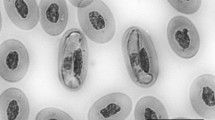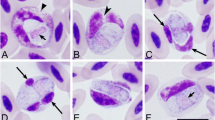Abstract
Developmental stages of Hepatozoon seurati (Laveran and Pettit 1911) comb. nov. are described from the tissues of the corned viper Cerastes cerastes, and from the vector Culex pipiens. The parasite described in the present study is firstly recorded as Haemogregarina seurati (Laveran and Pettit 1911) in the same host. After demonstration of the sporogonous development in the mosquito vector (C. pipiens) which showed all characteristics of the genus Hepatozoon (large oocysts containing many sporocysts producing numerous sporozoites), the parasite should be transferred into the genus Hepatozoon. The infected erythrocytes measured 20 ± 0.95 × 7.3 ± 0.85 μm; while uninfected cells measured 13.3 ± 1.04 × 7.5 ± 0.16 μm. Hypertrophy and faintly stained cytoplasm are mostly occurred in infected erythrocytes. Blood stages of the parasite were found exclusively in the erythrocytes in two forms: (1) small trophozoites (10.0 ± 0.52 × 3.0 ± 0.4 μm) and (2) long (mature) sausage-shaped (16.5 ± 1.5 × 3.5 ± 0.4 μm). Merogony occurred in the endothelial cells of the blood capillaries of lung, liver, and spleen. Mature meronts was 27.6 ± 0.7 × 17.5 ± 0.5 μm in diameter and contained 20–35 merozoites (averaged in 26). These merozoites measured 16.5 ± 1.5 × 3.5 ± 0.4 μm. Syzygy and gamogony occurred in the mosquito myxocoel till the 5th day post-infection (p.i.) while sporogony took place after 15 days p.i. On the third day p.i., a large spherical macrogamete of 29.0 ± 0.8 × 20.5 ± 0.6 μm containing a distinct nucleus in association with a single microgamete were observed. The microgamete was pyriform measured 8 ± 02 μm in length. It had a prominent nucleus and a long flagellum of at least 20.4 ± 1.3 μm in length. Fertilization occurred on the 3rd to the 4th days p.i. and the formed zygote developed into an oocyst in which repeated mitotic divisions with centripetal invaginations occurred producing sporoblasts. After sporulation, each sporoblast termed as sporocyst, and contained 18 banana-shaped sporozoites measured 14.0 ± 1.6 × 3.2 ± 0.6 μm. Experimental transmission was successful by intraperitoneal inoculation of the infective stages (sporozoites) to uninfected vipers and led to the appearance of blood stages after 5–6 weeks.



Similar content being viewed by others
References
Al Farraj S (2008) Light and electron microscopic study on a haemogregarine species infecting the viper Cerastes cerastes gasperitti from Saudi Arabia. Pak J Biol Sci 11:1414–1421
Al Ghamdi A, Morsy K, Bashtar AR, Abdel-Ghaffar F, Al-Rasheid K, Al-Quraishy S, Mehlhorn H (2011) Developmental stages of Hepatozoon hemprichii sp. nov. infecting the skink Scincus hemprichii and the tick Hyalomma impeltatum from Saudi Arabia. J Parasitol 97(5):878–883
Al Hoot AA (2008) Blood and lung stages of Haemogregarina sp. naturally infecting the snake Spalerosophis diadema cliffordi in Saudi Arabia with reference to its pathogenic effects on the host. Egypt J Zool 51:127–142
Al Hoot AA (2009) On a Haemogregarine sp. (Protozoa, Apicomplixa, Adeleina) naturally infecting the viper Bitis arientans in Saudi Arabia with reference to the host-parasite relationships. J Egypt Soc Parasitol 39:141–150
Allen KE, Yabsley MJ, Johnson EM, Reichard MV, Panciera RJ, Ewing SA, Little SE (2011) Novel Hepatozoon in vertebrates from the southern United States. J Parasitol 97(4):648–653
Allison B, Deser SS (1981) Developmental stages of Hepatozoon lygosomarum (Dore 1919) comb. n. (Protozoa, Haemogregarinidae), a parasite of a New Zealand skink, Leiolopisma nigriplantare. J Parasitol 67(6):852–858
Amo L, Lopez P, Martin J (2004) Prevalence and intensity of haemogregarinid blood parasites in a population of the Iberian rock lizards, Laerta monticola. Parasitol Res 94(4):290–293
Amo L, Lopez P, Martin J (2005) Prevalence and intensity of haemogregarine blood parasites and their mite vectors in the common wall lizard, Poodarcis muralis. Parasitol Res 96(6):378–381
Anderson (1898) Zoology of Egypt, Reptilia and Batrachia, London: Bernard Quaritch, 15 Piccadilly. 1:187–193
Ayala SC (1970) Hemogregarine from sand fly infecting both lizards and snakes. J Parasitol 56:387–388
Ball GH, Oda SN (1971) Sexual stages in the life history of the hemogregarine Hepatozoon rarefaciens. J Protozool 18:697–700
Ball GH, Chao J, Telford SR (1967) The life history of Hepatozoon rarefaciens (Sambon and Seligmann, 1907) from Drymarchon corais (Colubridae), and its experimental transfer to Constrictor constrictor (Boidae). J Parasitol 53(5):897–909
Ball GH, Chao J, Telford SR (1969) Hepatozoon fusifex sp. nov., a haemogregarine from Boa constrictor producing marked morphological changes in the infected erythrocytes. J Parasitol 55:800–813
Bashtar AR, Abdel Ghaffar F (1987) Light microscopic study on the life cycle of Haemogregarina najae infecting the snake Naja nigricollis (Elapidae, Proteroglypha, squamata) from Egypt. Proc Zool Soc Ar Egypt 14:33–44
Bashtar AR, Bouls R, Mehlhorn H (1984) Hepatozoon aegypti nov. sp. 1—life cycle. Parasitol Res 70:29–41
Bashtar AR, Abdel Ghaffar FA, Shazly MA, 6 (1987) Developmental stages of Hepatozoon gracilis (Wenyon, 1909) comb. nov., a parasite of the Egyptian skink, Mabuya quinquetaeniata. Parasitol Res 73:507–514
Bashtar AR, Abdel Ghaffar FA, Shazly MA (1991) Life cycle of Hepatozoon mehlhorni sp. nov. in the viper Echis carinatus and the mosquito Culex pipiens. Parasitol Res 77(5):402–410
Bashtar AR, Shazly MA, Ahmed AK, Fayed HM (1994) Life cycle of Hepatozoon matruhensis comb. nov. 1—blood stages and merogony inside the snake Psammophis schokari. J Egypt Ger Soc Zool 14:117–131
Bataille A, Fournié G, Cruz M, Cedeño V, Parker PG, Cunningham AA, Goodman SJ (2012) Host selection and parasite infection in Aedes taeniorhynchus, endemic disease vector in the Galápagos Islands. Genet Evol 12(8):1831–1841
Cook CA, Smit NJ, Davies AJ (2009) A redescription of Haemogregarina fitzsimonsi Dias, 1953 and some comments on Haemogregarinea parvula Dias, 1953 (Adelerina: Haemogregarinidae) from southern African tortoises (Cryptodira: Testudinidae), with new host data and distribution records. Folia Parasitol (Praha) 56:173–179
Desser SS, Hong H, Martin DS (1995) The life history, ultrastructure and experimental transmission of Hepatozoon catesbianea n. comb., an apicomplexan parasite of the bullfrog, Rana catesbeiana and the mosquito, Culex territans in Algonquin Park, Ontario. J Parasitol 81:212–222
Fantham HB, Cantab MA (1925) Some parasitic protozoa found in South Africa. VIII. S Afr J Sci 22:346–354
Furman DP (1966) Hepatozoon balfouri (Laveran 1905) sporogonic cycle, pathogenesis, and transmission by mites to jerboa hosts. J Parasitol 52:373–382
Göbel E, Krampitz HE (1982) histologische untersuchungen zur gamogonie und sporogonie von Hepatozoon erhardovae in experimentell infizierten rattenflohen (Xenopsylla cheopis). Parasitol Res (67): 261–271
Hoare CA (1920) On some new haemogregarines from British East Africa. Parasitology 12(4):315–327
Jakes KA, O'Donoghue PJ, Whittier J (2003) Ultrastructure of Hepatozoon boigae (Mackerras, 1961) nov. comb. from brown tree snakes, Boiga irregularis, from northern Australia. Parasitol Res 90(3):225–231
Krampitz HG, Wongchari V (1980) The development of Hepatozoon erhardovae in experimental mammalian and arthropod hosts. 1. The evaluation of suitable arthropod vectors, P. 349–58. : R. Traub & H. Starcke, eds., Fleas. Proc Int Conf Fleas Ashton England June 1977
Landau I (1973) A comparison of the life cycles of Toxoplasma and Hepatozoon, with reference to the general phenomenon and the role of cyst formation in the Coccidia. Ann Trop Med Parasitol 67(4):403–407
Levine ND (1982) Apicomplexa. In: Parker SP (ed) Synopsis and classification of living organisms, 1st edn. Mcgraw-Hill, New York, pp 571–587
Mackerras JM (1962) The life history of a Hepatozoon (Sporozoa; Adeleidea) of varanid lizards in Australia. Aust J Zool 10:35–44
Marx H (1968) Checklist of the reptiles and amphibians of Egypt. Spec Publ U S A, Naval Med. Res Unit No. 3 Cairo
Mathew JS, Ewing SA, Panciera RJ, Woods JP (1998) Experimental transmission of Hepatozoon americanum Vincet-Johnson et al., 1997 to dogs by the Gulf Cost tick, Amblyomma maculatum Koch. Vet Parasitol 80(1):1–14
Mehlhorn H (2008) Encyclopedia references of parasitology, 3rd edn. Springer, Berlin, Germany
Michel JC (1973) Hepatozoon mauritanicum Et. Et Ed. Sergent, (1904). n. comb., parasite de Testudo graeca: Redescription de la sporogone chez Hyalomma aegyptium et de la schizogonie tissularie d'apres Ie material d'E Brump. Ann Parasitol Hum Comp (48): 11–21
Moço TC, da Silva RJ, Madeira NG, Dos Santos Paduan K, Rubini AS, Leal DD, O'Dwyer LH (2012) Morphological, morphometric, and molecular characterization of Hepatozoon spp. (Apicomplexa, Hepatozoidae) from naturally infected Caudisona durissa terrifica (Serpentes, Viperidae). Parasitol Res 110(4):1393–1401
O'Dwyer LH, Moço TC, da Silva RJ (2004) Description of the gamonts of a small species of Hepatozoon sp. (Apicomplexa, Hepatozoidae) found in Crotalus durissus terrificus (Serpentes, Viperidae). Parasitol Res 92(2):110–112
O'Dwyer LH, da Silva RJ, Madeira NG (2011) Description of gamontogonic and sporogonic stages of Hepatozoon spp. (Apicomplexa, Hepatozoidae) from Caudisoma durissa terrifica (Serpentes, Viperidae). Parasitol Res 108(4):845–851
Paterson WB, Desser SS (1976) Observations on Haemogregarina balli sp. n. from the common snapping turtle, Chelydra serpentina. J Protozool 23(2):294–301
Peirce MA (1984) Some parasites of reptiles from Zambia and Indian Ocean islands with a description of Haemogregarina zambiensis sp. n. from Dispholidustypus (Colubridae). J Nat His 18:211–217
Roca V, Galdon MA (2010) Haemogregarine blood parasites in the lizards Podarcis bocagei (Seoane) and P. carbonelli (Perez-Mellado) (Sauria: Lacertidae) from NW Portugal. Syst Parasitol 75(1):75–79. doi:10.1007/s11230-009-9206-6
Shanavas KR, Ramachandran P (1990) Life-history of Hepatozoon octosporei sp. n., a new haemogregarine from the skink, Mabuya carinata (Schneider), with notes on the in vitro excystment of its oocysts. Arch Protistenkund 138(2):127–137
Shazly MA (1994) Electron microscopic studies on the gamogony and sporogony of Hepatozoon najae N. Com., inside the vector Culex pipiens. J Egypt Ger Soc Zool (14D) 195–212
Shazly MA (2000a) Light and electron microscopic studies on the life cycle of Hepatozoon stellio sp. nov. erythrocytic stages and merogony inside the Egyptian agamide lizard Agama stellio. J Egypt Ger Soc Zool 31:59–75
Shazly MA (2000b) Light and electron microscopic studies on the life cycle of Hepatozoon stellio sp. nov. Gamogony and sporogony inside the definitive hard tick Hyalomma impeltatum, with notes on its experimental transmission. J Egypt Ger Soc Zool 31:77–93
Shazly MA, Ahmed AK, Bashtar AR, Fayed H (1994) Life cycle of Hepatozoon matruhensis comb. nov. 2. Gamogony and sporogony inside the vector Culex pipens molestus. J Egypt Ger Soc Zool 4(D):323–340
Siddall ME, Desser SS (1993) Ultrastructure of merogonic development of Haemogregarina (sensu lato) myoxocephali (Apicomplexa: Adeleina) in the marine leech Malmiana scorpii and localization of infective stages in the salivary cells. Eur J Protistol 29(2):191–201. doi:10.1016/S0932-4739(11)80273-7, Epub 2011 Nov 2
Smith TG, Desser SS, Martin DS (1994) The development of Hepatozoon sipedon sp. nov. (Apicomplexa: Adeleina: Hepatozoidae) in its natural host, the Northern water snake (Nerodia sipedon sipedon), in the culicine vectors Culex pipiens and C. territans, and in an intermediate host, the Northern leopard frog (Rana pipiens). Parasitol Res 80(7):559–568
Telford SR Jr, Moler PE, Butler JF (2012) Four additional Hepatozoon species (Apicomplexa: Hepatozoidae) from north Florida rat snakes, genus Pantherophis. Folia Parasitol (Praha) 59(3):167–172
Acknowledgments
This work is supported by the Faculty of Science, Cairo University, Egypt and College of Science, King Saud University, Riyadh, Saudi Arabia.
Author information
Authors and Affiliations
Corresponding author
Rights and permissions
About this article
Cite this article
Morsy, K., Bashtar, A.R., Ghaffar, F.A. et al. Developmental stages of Hepatozoon seurati (Laveran and Pettit 1911) comb. nov., a parasite of the corned viper Cerastes cerastes and the mosquito Culex pipiens from Egypt. Parasitol Res 112, 2533–2542 (2013). https://doi.org/10.1007/s00436-013-3420-5
Received:
Accepted:
Published:
Issue Date:
DOI: https://doi.org/10.1007/s00436-013-3420-5




